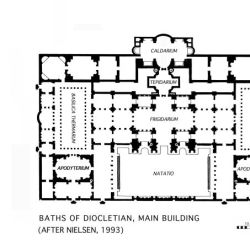The Baths of Trajan Decius — or of Philip the Arab?
Interpretation
Page 6

Fig. 3. Plan of the Baths of Caracalla, Rome (211/2 - 216 C.E.). After Nielsen (1993).
A flaw in La Follette’s analysis is her assumption that the rooms sketched by Palladio define the full extent of the central block of the baths. This assumption is entirely unwarranted. Palladio’s field sketch does not claim to present a complete ground plan of the complex in the way that a restored plan prepared for publication would.31 Palladio’s sketch shows us the parts of the ruins that he could see and measure but not what was absent, invisible or inaccessible because of stone-robbing, overbuilding or collapse.
The two surviving 3rd-c. imperial baths in Rome, the Baths of Caracalla (fig. 3) and the Baths of Diocletian (fig. 4), define the type. Their plans are essentially similar: compact rectangular blocks containing symmetrically arranged rooms with recognizable forms and functions: apodyteria (dressing rooms), natationes (swimming pools), basilicae thermarum (exercise or meeting halls), frigidaria (cold rooms), tepidaria (warm rooms) and caldaria (hot rooms).

Fig. 4. Plan of the Baths of Diocletian, Rome (298 - 305/6 C.E.). After Nielsen (1993).
Palladio’s plan tells us almost nothing about the central halls of the Baths of Decius, but we may reconstruct their outlines based on La Follette’s discoveries and comparison with the other 3rd-c. imperial baths. In order to take advantage of passive solar heating, the caldarium of the Baths of Decius undoubtedly projected from the center of the SW façade, exactly as in the other imperial baths of the period. This placement is confirmed by a feature noted by La Follette: underground corridors, clearly part of the heating system for the caldarium, extend under the patio of the casale Torlonia. (fig. 2) The tepidarium, a smaller, transitional space, was situated between rooms F and F’. It was separated from the caldarium by the two huge brick arches noted by La Follette and separated from the frigidarium by the parallel arches indicated on Palladio’s plan. This room was presumably heated by a hypocaust (hypocaustum), exposed during renovations in the NE portion of the casale, and the tubi (terra cotta wall flues), preserved in the lower level bathroom on the SE side of the same structure.32 The frigidarium, always the most impressive room in an imperial bath, must have occupied the entire space between the SE walls of D, B and A and the NW walls of D’, B’ and A’. All of these central spaces were apparently inaccessible to Palladio, probably because the collapse of the large vaults had filled them with rubble.33
It is unlikely that the patron of the Baths of Decius would have omitted the other essential elements of an imperial bath, although these features were not recorded by Palladio. The basilicae thermarum, rectangular halls surrounded by porticos, were probably placed symmetrically to the NW and SE of the portion of the ruins documented by Palladio. The large, rectangular natatio would presumably have been situated NE of the frigidarium and we would expect apodyteria to have flanked the natatio to the NW and SE.
31 Palladio sketched the Baths of Decius as part of his projected book on Roman baths, a project he never completed. He may not have continued work on the Baths of Decius beyond this initial freehand sketch, as no more finished version survives. Palladio may have been discouraged by the nature of the surviving remains and decided not to attempt to produce a complete restored plan. For Palladio’s working methods, see La Follette (1993) 189-90.
32 Corridors under presumed location of projecting caldarium: La Follette (1993) 55-56 and color fig. 20. Extant brick arches: ibid. 57-63, figs. 4, 10, 17, 18. Hypocaust and tubi: ibid. 55 n.160, 56 n.163.
33 La Follette (1993) 37-38.